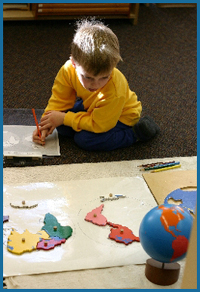

The Montessori method refers to the interaction of children, Montessori teaching materials, and specially trained Montessori teachers who plan, program and facilitate an environment to meet the observed needs of the individuals and the group. The primary goals of a Montessori program are to help each child reach full potential in all areas of life, and to help each child become a life-long learner.
The Montessori class is a working community of children and adults. Children are grouped into three-year classrooms (Preprimary: ages 3 through 6; Lower Elementary: ages 6 through 9; Upper Elementary: ages 9 through 12, to encourage peer learning and provide for individual differences, self-pacing and continuity.
Earth history, political geography and culture are grouped together with life sciences adjoining. Language, mathematics and geometry are each given their own areas within the classroom. The outdoor environment, including garden space, is an extension of the Montessori classroom. The larger community is part of the “going out” experience. Through field trips and community service related to the curriculum, the student views the world as his/her classroom.
Freedom Within Limits
Each Montessori class operates on the
principle of freedom within limits. Every program has its set of ground
rules which differ from age to age, but is always based upon core Montessori
beliefs: respect for each other and for the environment. Children
are free to work at their own pace with materials they have chosen, either
alone or with others. The Montessori teacher relies on his or her
observations of the children to determine which new activities and materials
may be introduced to an individual child or to a small or large group.
The objective is to encourage active, self-directed learning and to strike a
balance of individual mastery with small group collaboration throughout the
whole classroom community. Multi-age grouping in each classroom provides
a family-like setting where learning can take place naturally and
cooperatively. More experienced children share what they have learned
while reinforcing their own learning.
Concentration and Hands-On Learning
The Montessori method emphasizes that the mind and hand are intimately
connected in acquiring knowledge and understanding at all developmental
levels. In order to learn, there must be concentration, and the best way
a child can learn concentration is by fixing his attention on some tasks he is
performing with his hands. (The adult habit of doodling is an example of
this practice). All the equipment in a Montessori classroom allows the
child to acquire knowledge and develop his concentration skills by facilitating
self-paced learning through observation and repeated practice with manipulative
objects.